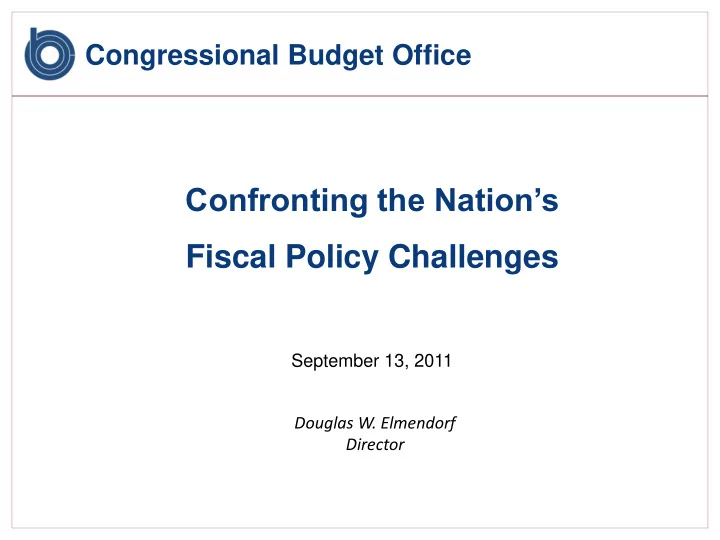

Congressional Budget Office Confronting the Nation’s Fiscal Policy Challenges September 13, 2011 Douglas W. Elmendorf Director
Real Gross Domestic Product Trillions of 2005 Dollars, Logarithmic Scale
Net Job Growth per Month Thousands of jobs
Unemployment Rate Percent
Inflation Percentage change in prices from previous year
Deficits in CBO’s Baseline and Assuming a Continuation of Certain Policies Percentage of GDP
Federal Debt Held by the Public Percentage of GDP
Enforcement Procedures of the Budget Control Act If no legislation originating from this Committee was enacted, the following would occur over the coming decade: Reductions in the caps on discretionary appropriations for defense would cut outlays by about $450 billion. Reductions in the caps on discretionary appropriations for nondefense purposes would cut outlays by about $300 billion. Reductions in mandatory spending would yield net savings of about $140 billion. Debt-service costs would decline by about $170 billion. The total reduction in deficits would be about $1.1 trillion.
Fiscal Policy Choices How much deficit reduction should be accomplished? How quickly should deficit reduction be implemented? What forms should deficit reduction take?
Federal Revenues and Spending in 2021 Under CBO’s Baseline or with a Continuation of Certain Policies
Trade-offs in the Timing of Deficit Reduction Cutting spending or increasing taxes slowly would lead to a greater accumulation of government debt and might raise doubts about whether the longer-term deficit reductions would ultimately take effect. Implementing spending cuts or tax increases abruptly would give little time to plan and adjust. In addition, and particularly important given the current state of the economy, immediate spending cuts or tax increases would represent an added drag on the weak economic expansion.
Near-Term Economic Effects of Deficit Reduction Credible policy changes that would substantially reduce deficits later in the coming decade and beyond — without immediate spending cuts or tax increases — would both support the economic expansion in the next few years and strengthen the economy over the longer term. There is no inherent contradiction between using fiscal policy to support the economy today, while the unemployment rate is high and many factories and offices are underused, and imposing fiscal restraint several years from now, when output and employment will probably be close to their potential.
Revenues and Spending, Excluding Interest Percentage of GDP
Revenues by Source Percentage of GDP
Average Federal Tax Rates, by Income Quintile,1979 to 2007
Marginal Tax Rates (Income and Payroll) on Earnings for a Family of Four with a Single Earner, 1971 to 2011 Percent
Spending for Social Security, Medicare, and Other Major Health Care Programs Percentage of GDP
Other Federal Spending, by Category Percentage of GDP
Federal Revenues and Spending Historically and in 2021 Under CBO’s Baseline
Cumulative Budgetary Effect of Major Income Tax Expenditures, 2010 to 2014
Conclusion Given the aging of the population and rising costs for health care, attaining a sustainable federal budget will require the United States to deviate from the policies of the past 40 years in at least one of the following ways: Raise federal revenues significantly above their average share of GDP; Make major changes to the sorts of benefits provided for Americans when they become older; or Substantially reduce the role of the rest of the federal government relative to the size of the economy.
Recommend
More recommend